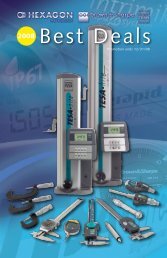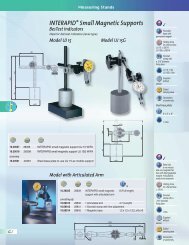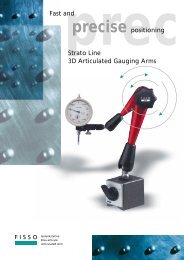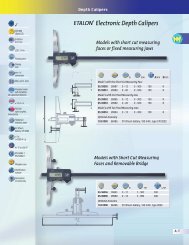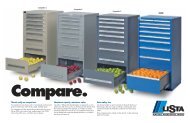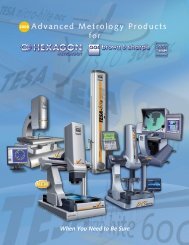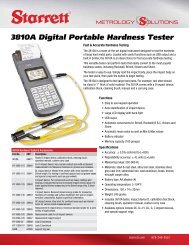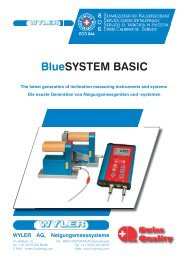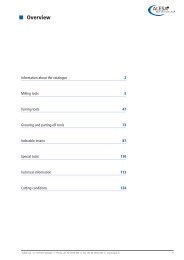Wyler Technical Document - Swiss Instruments Ltd
Wyler Technical Document - Swiss Instruments Ltd
Wyler Technical Document - Swiss Instruments Ltd
You also want an ePaper? Increase the reach of your titles
YUMPU automatically turns print PDFs into web optimized ePapers that Google loves.
INTRODUCTION<br />
to<br />
INCLINATION MEASUREMENT<br />
Introduction in INCLINATION MEASUREMENT
Possible applications with inclination measuring instruments<br />
t<br />
STRAIGHTNESS<br />
GERADHEIT<br />
INCLINATION<br />
NEIGUNG<br />
RECTANGULARITY<br />
RECHTWINKLIGKEIT<br />
PARALLELISM<br />
PARALLELITÄT<br />
FLATNESS<br />
EBENHEIT<br />
MONITORING<br />
ÜBERWACHUNG<br />
Applications
Vials<br />
Precision Spirit Levels for small angles<br />
0<br />
180<br />
Vials / CLINOMETER<br />
Adjustable Precision Spirit Levels for angles<br />
up to 360 degrees (CLINOMETERS)<br />
Capacitive systems<br />
Analogue systems<br />
MINILEVEL / LEVELTRONIC / LEVELMATIC<br />
Digital systems<br />
ZEROTRONIC / CLINOTRONIC<br />
C 1 C 2<br />
Inductive systeme with pendulums<br />
Inductive systeme with pendulums<br />
Analogue systems<br />
NIVELTRONIC<br />
Digital systems<br />
ZEROMATIC 50<br />
Grundsysteme
Vial for a standard precision spirit level<br />
Ground vial for precision spirit levels<br />
radius = 5 ... 200 meter<br />
R<br />
Bent vial (low cost version)<br />
radius = 0.5 ... 1 Meter<br />
R<br />
VIALS
Precision Spirit Levels WYLER<br />
Horizontal Spirit Level<br />
Precision Spirit Level<br />
with magnetic inserts<br />
Precision Frame Spirit Level<br />
Clinometer 80<br />
0 ... 360°<br />
Spirit Levels I
NEW!!! Precision Spirit Levels WYLER „SPIRIT“<br />
Most important advantages of the<br />
new concept:<br />
1. Simple adjustment system<br />
2. Excellent view on the vial<br />
3. Modern design<br />
4. Fully in compliance to<br />
DIN standards<br />
5. Stability of twist to +/- 5 degrees<br />
6. Comfortable handling due to<br />
the use of natural material<br />
Spirit Levels II „SPIRIT“
Most common units used in inclination measurement/<br />
description of an angle<br />
α<br />
Basis length<br />
1m x 1000 = 1km<br />
Height H= 1µm<br />
x 1000<br />
= 1mm<br />
1. Angle α, e.g. in xx°xx‘xx‘‘ or in mRad<br />
2. Height h refering to a basis length, e.g. mm/m or µm/m<br />
Example: 1µm/m = 1mm/km<br />
mm / m ?
Most common units used in inclination measurement<br />
XX° XX'<br />
XX' XX''<br />
XX , X µm/m<br />
XXX mRad<br />
Degrees and Arcmin<br />
Arcmin and Arcsec<br />
1 µm equivalent to 1/1'000'000 m<br />
1 mRad equivalent to 206,26 Arcsec<br />
1 Rad is equivalent to 57,29 °<br />
1 mRad is equivalent to 206,26 26 Arcsec<br />
1 Degree is equivalent to approx. 17,45 mm/m or 17,45 mRad<br />
1 Arcsec is equivalent to approx. 4,85 µm/m<br />
Display Minilevel "classic" in digits equivalent to µm/m<br />
Display Minilevel "NT" in units like mm/m and Arcsec<br />
Units for +CLINO PLUS+ / CLINO 2000<br />
XX° XX'<br />
X,XXXX°<br />
XX,XX°<br />
XX'XX''<br />
XX,XX mm/m<br />
,XXXX mm/m<br />
XX,XX mRad<br />
UNITS
Electronic inclination measurement in general<br />
Purpose of the instrument:<br />
Transformation of a mechanically measured value into an electronic signal<br />
Existing Systems<br />
Inductive Systems (Niveltronic)<br />
Capacitive Systems (Minilevel, Leveltronic, Zerotronic, Clinotronic)<br />
Resistive Systems (e.g. by means of vials based on electrolysis)<br />
Laser<br />
Capacitive Sensors:<br />
An inclination of 1 μm/m causes a pendulum movement of 10 up to 20 nm<br />
Thickness of a hair<br />
approx. 50 up to 70 μm/m<br />
(Measuring the thickness of a hair as an excercise)<br />
Basics
Exercise<br />
,044 ,430<br />
"diameter of a hair"<br />
ØHair ?<br />
Instrument: Minilevel 1µm/m<br />
Base length: 150mm<br />
140mm<br />
Heigth H = (+430 - +044) x sensitivity<br />
H<br />
Diameter hair ?<br />
140mm<br />
1000mm<br />
Diameter of a hair D H :<br />
Diameter hair D H =<br />
(value 2 - value 1) x sens. instrument x distance “base ... hair”<br />
base length 1000 mm<br />
Diameter hair D H =<br />
(+430 - +044) x 1 µm/m x 140 mm = 54 µm<br />
base length 1000 mm<br />
Hair
Electronic Inclinometers WYLER<br />
Summary of<br />
Electronic Inclinometers<br />
Overview el.<br />
instruments
Analogue and digital measuring systems<br />
Analogue measuring system<br />
Digital measuring system<br />
Measuring value:<br />
Voltage<br />
Output<br />
in mV / unit (digit)<br />
Measuring value :<br />
Frequency<br />
Output<br />
frequencies f1 and f2<br />
Format RS485<br />
MINILEVEL „classic“<br />
LEVELTRONIC „classic“<br />
NIVELTRONIC<br />
LEVELMATIC<br />
MINILEVEL „NT“<br />
LEVELTRONIC „NT<br />
CLINOTRONIC 15<br />
CLINO 2000<br />
ZEROTRONIC<br />
analogue / digital
Sine, tangent and arcus<br />
in accordance with angles<br />
tg α<br />
α<br />
arc α<br />
Important:<br />
t<br />
1 µRad = 1 µm/m<br />
is valid for small angles only<br />
sin α<br />
sin α tg α arc α<br />
α = 0,5° 0,00872660087266 0,00872690087269 0,00872660087266<br />
α = 45° 0,70711 1,00 0,78540<br />
Einheitskreis
Linearity<br />
Sensitivity<br />
Angle<br />
mechanical<br />
input<br />
20µm/m<br />
10µm/m<br />
Measured<br />
characteristic<br />
5µm/m<br />
Nominal<br />
characteristic<br />
maximum<br />
error of linearity<br />
1µm/m<br />
Angle<br />
DIN 2276<br />
Measured value below half the measuring range<br />
Maximum error 1% of the measured value,<br />
at least 0,05% of the measuring range<br />
Output<br />
(mV, digits, ...)<br />
For measured values above half the measuring<br />
range<br />
Maximum error f max = 0,01 (2 x I M v I - 0,5 x M r )<br />
Linearity
Part 2<br />
Inclination measuring instruments<br />
t<br />
of<br />
analogue (and digital)<br />
technique<br />
Analogue Systems / TITEL
NIVELTRONIC 50<br />
Range II: +/- 0.150 mm/m<br />
Range I: +/- 0.750 mm/m<br />
Excellent zero point stability<br />
Measuring priciple:<br />
Pendulum with inductive<br />
probe system<br />
induktiver<br />
Messtaster<br />
L1 L2<br />
U1 U2<br />
Niveltronic
Analogue measuring priciple<br />
t<br />
6Vpp2,9kHz<br />
Amplifier Rectifier Integrator<br />
U a<br />
U g<br />
U out<br />
t<br />
U 1 U 2<br />
-2...0...+2 V DC<br />
Ua Ug Uout<br />
Pendulum closer to C L<br />
Ua Ug Uout<br />
Pendulum in neutral position<br />
Ua Ug Uout<br />
Pendulum closer to C R<br />
Prinzip I
Analogue / digital measuring principle<br />
U1<br />
t<br />
Amplifier Rectifier Integrator<br />
U2<br />
4 Vpp 2.9kHz<br />
t<br />
U 1 U 2<br />
Ua<br />
U g<br />
U out<br />
-2...0...+2 V DC<br />
Ua Ug Uout<br />
A<br />
D<br />
U out<br />
RS 485<br />
Pendulum closer to C L<br />
Ua Ug Uout<br />
Pendulum in neutral position<br />
Ua<br />
Ug<br />
Uout<br />
Pendulum closer to C R<br />
Prinzip II ML/LT NT
Form of the pendulum<br />
Variables depending on<br />
the measuring range<br />
- Thickness of pendulum<br />
50 ... 100μm<br />
- Angle of spiral<br />
300 ... 630°<br />
e.g. Pendulum with 420°<br />
Form Pendulum
Movement of the pendulum depending on the angle<br />
Z<br />
X = Gravitation of pendulum<br />
Y = sin α x X<br />
Z = movement of pendulum<br />
Y<br />
α X<br />
Sine of angle in a range<br />
from 0... 45 degrees<br />
0,0030<br />
0,0015<br />
(Z)<br />
sin α<br />
1,0<br />
0,8<br />
0,6<br />
0,4<br />
(Z)<br />
sin α<br />
0,2<br />
1 2 3 4 5 6 7 8 9<br />
10 20 30 40 50 60 70 80 90<br />
Arcmin<br />
Sine of angle in a range<br />
degrees<br />
from 0...10 Arcmin<br />
Pendelauslenkung
Movement of the pendulum depending on the angle<br />
Z<br />
α X<br />
X = Gravitation of pendulum<br />
Y = sin α x X<br />
Z = movement of pendulum<br />
Y<br />
Movement of the pendulum<br />
in direction Y<br />
e.g. Minilevel A10:<br />
For an inclination of<br />
1µm/m ... 10 nm<br />
Pendelauslenkung II
Reversal Measurement<br />
Zero Point deviation<br />
of the instrument<br />
Interpretation of the results:<br />
Inclination of the measured<br />
surface in direction X<br />
Measurement A Measurement B<br />
N=(A+B)/2<br />
N=(A - B) / 2<br />
The Zero Point deviation<br />
is +3 equivalentto,3digits<br />
to N=[(+3) + (+3)] / 2 = +3<br />
The surface is absolutely<br />
horizontal<br />
L = [(+3) - (+3)] / 2 = 0<br />
The instrument has no<br />
Zero Point deviation<br />
N=[(-12) + (+12)] / 2 = 0<br />
The measured surface is<br />
declining by -12 digits<br />
L =[(-12) - (+12)] / 2 = -12<br />
The Zero Point deviation<br />
is -3 equivalent to '3 Digits<br />
N=[(+7) + (-13)] / 2 = -3<br />
The measured surface is<br />
rising by +10 Digits<br />
L =[(+7) - (-13)] / 2 = +10<br />
Reversal measurement
MINILEVEL "classic" / A10<br />
,1204<br />
1 Digit = 1mV<br />
Position “0”: Instrument turned off<br />
Position “B”: Battery check (minimum i 700)<br />
Position “I”: Value effective = display in digits<br />
x factor 10 x sensitivity<br />
Position “II”: Value effective = display in digits<br />
x sensitivity<br />
1 µm/m 5 µm/m 10 µm/m<br />
In position “I” 12’040 µm/m 60’200 µm/m 120’400 µm/m<br />
In position “II” 1204 µm/m 6020 µm/m 12’040 µm/m<br />
Sensitivities MINILEVEL / 1 Digit = 1 mV<br />
1µm/m 5µm/m 10 µm/m<br />
In position “I” 10 µm/m 50 µm/m 100 µm/m<br />
In position “II” 1 µm/m 5 µm/m 10 µm/m<br />
ML Overview
MINILEVEL "classic" / A10<br />
,005 means +5 Digits<br />
Position II: Measured value = + 5 digits x<br />
sensitivity<br />
005 Position I: Measured value = + 5 digits x<br />
sensitivity x 10<br />
,005<br />
'125 means -125 Digits<br />
`125<br />
Position II: Measured value = - 125 digits x<br />
sensitivity<br />
Position I: Measured value = - 125 digits x<br />
sensitivity x 10<br />
ML Overview
LEVELTRONIC "classic" / A40<br />
LEVELMETER<br />
'1204<br />
A B OUT<br />
1 µm/m 5 µm/m 10 µm/m<br />
Display - 1204 µm/m - 6020 µm/m - 12040 µm/m<br />
Sensitivities MINILEVEL / 1 digit = 1 mV<br />
1µm/m 5µm/m 10 µm/m<br />
Display 1 µm/m 5 µm/m 10 µm/m<br />
LT Overview
LEVELTRONIC "classic" with Levelmeter 25,<br />
Differential measurement<br />
Measuring direction<br />
Levelmeter<br />
LEVELMETER<br />
'1204<br />
Measuring instrument<br />
Red<br />
cable<br />
A B OUT<br />
Reference instrument<br />
Grey cable<br />
LT Overview
MINILEVEL “NT" / A11<br />
1 µm/m: 5 µm/m 10 µm/m<br />
Range 1: +/- 20 mm/m +/- 100 mm/m +/- 200 mm/m<br />
Range 2: +/- 2 mm/m +/- 10 mm/m +/- 20 mm/m<br />
Output:<br />
1mV / 1µm/m 1mV / 5µm/m 1mV / 10µm/m<br />
or Angle in µm/m or Arcsec (Format RS485)<br />
WYLER AG SWITZERLAND<br />
Range II<br />
mm/m<br />
+<br />
M<br />
-<br />
M<br />
Aus/Off<br />
Messen / Measuring<br />
Justierung Nullpunkt<br />
Adjustment Zero<br />
Einstellung Messbereich<br />
Changing Range<br />
MINILEVEL NT /<br />
> 5 sec<br />
> 60 min<br />
+ / -<br />
+ / -<br />
ML NT Display
Display / Output<br />
MINILEVEL „classic“<br />
Output: +/- 2000 mV<br />
1 digit =<br />
MINILEVEL „NT“<br />
1 mV Output:<br />
LM C25<br />
LEVELMETER<br />
'1204<br />
Display :<br />
Range II: +/- 2000 digits<br />
Range I: +/- 2000 digits<br />
+/- 2000 mV<br />
and / or<br />
A B OUT<br />
Display:<br />
Range II: Angle in µm/m or Arcsec<br />
Range I: Angle in µm/m or Arcsec<br />
Angle in<br />
format RS485<br />
LM2000<br />
Display/Output
MINILEVEL “NT" / A11<br />
WYLER<br />
SEAL-TEC R<br />
LCD-Print<br />
Processor-<br />
Print<br />
+/-2V DC<br />
or<br />
RS485<br />
Sensor with pendulum / N 2 (nitrogene)<br />
ML NT Display
MINILEVEL NT and LEVELTRONIC NT<br />
The new productline MINILEVEL NT / LEVELTRONIC NT is well suited for<br />
precision i measurements of small angles.<br />
MINILEVEL NT<br />
LEVELTRONIC NT<br />
- Large LCD digital display, two sensitivities can be selected<br />
(MINILEVEL NT only)<br />
- Precise zero point adjustment by using the push buttons<br />
- Rugged precision aluminium housing for protecting against<br />
external influences<br />
- State of the art digital technology combined with the use of<br />
modern electronic components allows signal output<br />
in digital it and analogue form<br />
- Possibility of connection to a Levelmeter C25 or<br />
Levelmeter 2000, as well as to the Leveladapterset 2000<br />
combined with the flatness measurement software<br />
“WYLER LEVELSOFT”<br />
- Power supply with common 1,5 V-Batteries<br />
- Fulfils the CE requirements (immunity against<br />
electromagnetic smog)<br />
- All standard measuring bases are available<br />
- Available with calibration in Arcsec or µm/m<br />
ML vs LT
Choice of the ideal instrument<br />
MINILEVEL "classic"<br />
"<br />
- Installation and adjustment of machines<br />
- Measurement of surface flatness<br />
- No interference by magnetic<br />
fields (Electric motors etc.)<br />
- Highly shock resistant<br />
- Integrated display<br />
- 2 ranges of measurement, useful<br />
for coarse adjustment<br />
MINILEVEL "NT"<br />
LEVELTRONIC "classic"<br />
- Installation and adjustment of machines<br />
- No interference by magnetic<br />
fields (Electric motors etc.)<br />
-Highly shock resistant<br />
- External display (Levelmeter)<br />
- More accurately than Minilevel when<br />
differential mode is applied<br />
- Measurement of surface flatness LEVELTRONIC "NT"<br />
Auswahl ML-LT
WYLER PROGRAM LEVELSOFT / Introduction<br />
Line /<br />
Straightness<br />
Parallels<br />
with/without twist<br />
Flatness<br />
WYLER Standard<br />
and U-Jack<br />
Rectangularity<br />
Introduction SW LEVELSOFT
Adjustment of Measuring results<br />
The following methods of adjustments are used:<br />
Adjustment<br />
- End points method<br />
- ISO1101<br />
- Linear regression<br />
Example: Measurement of a line<br />
Linear<br />
regression<br />
9.5µm<br />
+6<br />
+4<br />
+2<br />
0<br />
-2<br />
End points<br />
-4<br />
ISO 1101 10µm<br />
-6<br />
9µm<br />
Adjustment ISO1101 Line
Adjustment of Measuring results<br />
The following methods of adjustments are used:<br />
Adjustment<br />
End points method<br />
Example: Measurement of a line<br />
+6<br />
+4<br />
+2<br />
0<br />
-2<br />
End points<br />
-4<br />
10µm<br />
-6<br />
Adjustment ISO1101 Line
Adjustment of Measuring results<br />
The following methods of adjustments are used:<br />
Adjustment<br />
ISO1101<br />
Example: Measurement of a line<br />
+6<br />
+4<br />
+2<br />
0<br />
-2<br />
-4<br />
-6<br />
ISO 1101<br />
9µm<br />
Adjustment ISO1101 Line
Adjustment of Measuring results<br />
The following methods of adjustments are used:<br />
Adjustment t Linear regression<br />
Example: Measurement of a line<br />
Linear<br />
regression<br />
9.5µm<br />
+6<br />
+4<br />
+2<br />
0<br />
-2<br />
-4<br />
-6<br />
Adjustment ISO1101 Line
Measuring a line<br />
(as preparation for flatness<br />
measurement)<br />
SW WYLER according to ISO1101<br />
LEVELMETER<br />
Moving direction '1204<br />
A B OUT<br />
Example:<br />
Sensitivity of instrument: 1 µm/m<br />
Base length: 200 mm<br />
Step length: 180 mm<br />
- -4 + +16 + +2 + -4 -2 +7<br />
Maximum error:<br />
13,5 µm x 180 mm<br />
1000 mm<br />
+16<br />
+2 -4<br />
= 2,43 µm =13,5µm<br />
0<br />
-2<br />
+7<br />
(reduced to the step length of 180 mm)<br />
-4<br />
Linienmessung
Measuring a line<br />
(as preparation for flatness measurement)<br />
Moving direction<br />
- -4<br />
Remark:<br />
0.72 µm<br />
When using the<br />
WYLER-Software for<br />
measuremnt the<br />
effective value will be<br />
read in<br />
-4 µm/m<br />
180 mm<br />
1000 mm<br />
Linienmessung II
Measurement of two guide ways<br />
Exercise<br />
Prosedure:<br />
1. Measuring the reference line<br />
2. Measuring the parallel guide way<br />
3. Measuring the transversal lines<br />
Remarks:<br />
The reliability of the measurement may be<br />
judged by the resulting closure error<br />
Parallel guide way<br />
Reference line<br />
Vermessung von Führungsbahnen
Measurement of 90° angles on<br />
measuring bases and workpieces<br />
1 2<br />
+ -<br />
+ -<br />
α<br />
2 Referenz<br />
1<br />
α<br />
+ -<br />
+ -<br />
Correction =<br />
C + D<br />
2<br />
A + B<br />
2<br />
+ -<br />
2 1<br />
+ -<br />
-<br />
Referenz<br />
α + -<br />
α<br />
Referenz<br />
1 2<br />
+ -<br />
B<br />
A<br />
D<br />
C<br />
Vermessung von Messbasen und rechten Winkeln
Measurement of a 90° angle<br />
Exercise:<br />
4µm<br />
6µm<br />
Vermessung eines rechten Winkels
Measurement of a 90° angle<br />
with Software LEVELSOFT<br />
1. Step: Determining the angular error of the instrument using a master<br />
square with parallel sides<br />
A B C D<br />
Angular error = C + D<br />
2<br />
-<br />
A + B<br />
2<br />
2. Step: Measurement of the 90 deg. angle of the object / 4 different possibilities<br />
1<br />
2<br />
Referenz<br />
2<br />
1<br />
The <strong>Wyler</strong> LEVELSOFT is leading the way<br />
through the different software menus<br />
2<br />
1<br />
1<br />
2<br />
Vermessung eines rechten Winkels
Measurement of a 90° angle<br />
with Software LEVELSOFT<br />
3. Step: Alignment of the measuring object and determining the error<br />
a) Alignment of the reference line according to ENDPOINTS<br />
ANGLE / ENDPOINTS<br />
0.5 µm<br />
0.4 µm<br />
0.3 µm<br />
02µm 0.2 0.1 µm<br />
0,0 µm<br />
ERROR REFERENCE LINE 0.6 µm<br />
ERROR 2ND LINE BASED ON ISO1101 0.6 µm<br />
The error of the second line is shown<br />
according to the various<br />
alignment methods:<br />
- ISO 1101<br />
- ENPOINTS<br />
- LINEAR REGRESSION<br />
END POINTS 0.2 µm<br />
LINEAR REGRESSION 0.1 µm<br />
CORRECTION OF INSTRUMENT -2,58 µm/m<br />
Vermessung eines rechten Winkels
Measurement of a 90° angle<br />
with Software LEVELSOFT<br />
3. Step: Alignment of the measuring object and determining the error<br />
b) Alignment of the reference line according to ISO 1101<br />
ANGLE / ISO1101<br />
0.5 µm<br />
0.4 µm<br />
0.3 µm<br />
02µm 0.2 0.1 µm<br />
0,0 µm<br />
ERROR REFERENCE LINE 0.5 µm<br />
ERROR 2ND LINE BASED ON ISO1101 0.7 µm<br />
The error of the second line is shown<br />
according to the various alignment<br />
methods:<br />
- ISO 1101<br />
- ENPOINTS<br />
- LINEAR REGRESSION<br />
END POINTS 0.1 µm<br />
LINEAR REGRESSION 0.2 µm<br />
CORRECTION OF INSTRUMENT -2,58 µm/m<br />
Vermessung eines rechten Winkels
Measurement of a 90° angle<br />
with Software LEVELSOFT<br />
3. Step: Alignment of the measuring object and determining the error<br />
c) Alignment of the reference line according to LINEAR REGRESSION<br />
ANGLE / LINEAR REGRESSION<br />
0.5 µm<br />
0.4 µm<br />
0.3 µm<br />
02µm 0.2 0.1 µm<br />
0,0 µm<br />
ERROR REFERENCE LINE 0.5 µm<br />
ERROR 2ND LINE BASED ON ISO1101 0.6 µm<br />
The error of the second line is shown<br />
according to the various alignment<br />
methods:<br />
- ISO 1101<br />
- ENPOINTS<br />
- LINEAR REGRESSION<br />
END POINTS 0.0 µm<br />
LINEAR REGRESSION 0.1 µm<br />
CORRECTION OF INSTRUMENT -2,58 µm/m<br />
Vermessung eines rechten Winkels
Adjustment of Measuring results at an object<br />
with a square angle<br />
Reference measurement ( Reference line)<br />
Adjusted<br />
measuring line<br />
Reference<br />
ISO 1101<br />
9µm<br />
Original<br />
measurement<br />
Tilting the<br />
reference<br />
line<br />
Line<br />
Original<br />
measurement<br />
Adjusted<br />
measuring line<br />
Linear<br />
Regression<br />
Procedure:<br />
1. Measuring the square object<br />
2. Tilting the reference line according to ISO 1101<br />
(square line is tilting identically)<br />
3. Display of the total rectangular error<br />
(in the example measuring line to reference line)<br />
a) according to “End points”<br />
b) according to “ISO 1101” End points 4.5µm<br />
c) according to “linear regression”<br />
Linear Regression<br />
2.1µm<br />
Tilting the line the<br />
same way the<br />
reference line<br />
was tilted<br />
Ausrichtung rechtwinklige Objekte<br />
ISO 1101 9.6µm
Flatness Measurement with WYLER Inclinometers<br />
and WYLER Software<br />
SURFACE GRID WYLER<br />
Length: 1200 mm<br />
Witdh: 800 mm<br />
Maximum error: 4,0 μm<br />
Graphic display of profile<br />
Closure error: 0,3 μm<br />
As an option the connection to a PC is available:<br />
Options:<br />
- Leveladapter<br />
- Measurement-Software<br />
Engineer Set consists of:<br />
- 2 Minilevel "NT"<br />
Operating Systems:<br />
DOS / Win 3.11 / WIN 95 / Win NT 3.5 or higher - Levelmeter 2000<br />
- Cable with „dongle“<br />
Ebenheitsmessungen mit WYLER Messgeräten<br />
und Mess-Software
Flatness measurement with LEVELTRONIC "classic"<br />
Moving direction<br />
Measuring instrument<br />
Personal Computer<br />
LEVELMETER<br />
'1204<br />
Leveladapter 2000<br />
A B OUT<br />
Reference instrument<br />
ATTENTION: - Connect the red cable to the measuring instrument<br />
- Always measure in the direction of the cable<br />
Flächenmessung mit LEVELTRONIC "classic"
Flatness measurement with MINILEVEL "classic"<br />
Moving direction<br />
Personal Computer<br />
Measuring instrument<br />
Leveladapter 2000<br />
Reference instrument<br />
ATTENTION: - Remove batteries (MINILEVEL "classic" only)<br />
- Check the correct sensitivity<br />
- Connect the red cable to the measuring instrument<br />
- Always measure in the direction of the cable<br />
Flächenmessung mit MINILEVEL "classic"
Flatness measurement with LEVELTRONIC NT<br />
Measuring instrument<br />
Personal Computer<br />
LEVELMETER<br />
'1204<br />
Leveladapter 2000<br />
A B OUT<br />
Reference instrument<br />
ATTENTION: - Check the sensitivity when using MINILEVEL NT<br />
- Connect the red cable to the measuring instrument<br />
-Always measure in the direction of the cable<br />
LT NT ML25/Leveladapter 2000
Flatness measurement with MINILEVEL NT<br />
Personal Computer<br />
Measuring instrument<br />
Leveladapter 2000<br />
Reference instrument<br />
ATTENTION: - Check the sensitivity when using MINILEVEL NT<br />
- Connect the red cable to the measuring instrument<br />
-Always measure in the direction of the cable<br />
LT NT Leveladapter 2000
Flatness measurement with MINILEVEL NT or<br />
LEVELTRONIC NT with Levelmeter 2000<br />
Measuring<br />
instrument<br />
Levelmeter 2000<br />
Reference instrument<br />
t<br />
Using a Levelmeter 2000 instead of a Levelmeter C25<br />
additional features are available like:<br />
"ZERO"-Setting, various measuring units, and so on<br />
LT NT Levelmeter 2000
NEW !!!<br />
„Remote Display“ for MINILEVEL and LEVELTRONIC „NT“<br />
LT NT with remote display
Preparation for Flatness Measurement<br />
1. Cleaning of the surface plate (on the previous day)<br />
2. Place the instruments on the surface plate for acclimatization<br />
3. Connecting the instruments (and Levelmeter) to the computer;<br />
remove batteries (Levelmeter, Minilevel “classic” only)<br />
4. Turn on the Leveladapter 2000<br />
5. Turn on the computer (after connecting the<br />
instruments)<br />
6. Adjust surface plate to within +/- 50 µm/m with<br />
Spirit Level or Leveltronic/Minilevel.<br />
Attention: Loosen the safety supports first !<br />
7. Prepare the software programme for the<br />
measurement with the necessary data<br />
Attention: When measuring with 2 Leveltronics<br />
and Levelmeter,<br />
INPUT: "Measurement with one<br />
instrument"<br />
Adjust correct sensitivity<br />
8. Calculation of the best fit grid and draw it on the<br />
surface plate, after that cleaning of the plate again.<br />
Free space at edge minimum 1/2 base width.<br />
9. Execute test measurement, line with<br />
approx. 20 steps without moving the instrument<br />
10. Start with flatness measurement, check correct<br />
switch position of MINILEVEL<br />
11. After the measurement apply MICROPOLISH for conditioning the plate<br />
Vorbereitungen Ebenheit
Basics on surface flatness measurement<br />
Influence of temperature:<br />
A temperature difference of 1 degree Celsius between the upper and the lower side of a plate of<br />
1m length results already in a deformation of the plate of 6 to 7 µm<br />
Surface flatness according to DIN 876 / ISO1101:<br />
Flatness of granite surface plates (DIN 876 / ISO1101)<br />
Quality Maximum error in µm<br />
00 2 x ( 1 + Länge in [m] )<br />
0 4 x ( 1 + Länge in [m] )<br />
1 10 x ( 1 + Länge in [m] )<br />
2 20 x ( 1 + Länge in [m] )<br />
Length: 1200 mm<br />
SURFACE GRID WYLER<br />
Witdh: 800 mm<br />
Choice of measuring base:<br />
Ideal measuring base: Flat steel base with dust groves<br />
Measuring step length:<br />
Maximum error: 4,0 μm<br />
Length of the base Optimal step length Recommended step length<br />
110 mm 90 mm 85 ... 105 mm<br />
150 mm 126 mm 120 ... 145 mm<br />
200 mm 170 mm 160 ... 190 mm<br />
Closure error: 0,3 μm<br />
Schrittlänge
Basics on surface flatness measurement<br />
Prerequisite:<br />
• Max. temp. difference top/bottom = 2°C<br />
• After cleaning: 2 hours drying time<br />
SURFACE GRID WYLER<br />
Length: 1200 mm<br />
Witdh: 800 mm<br />
Grade t 1 in µm<br />
00<br />
0<br />
1<br />
2<br />
2 (1 + Länge in m)<br />
4 (1 + Länge in m)<br />
10 (1 + Länge in m)<br />
20 (1 + Länge in m)<br />
Maximum error: 4,0 μm<br />
Closure error: 0,3 μm<br />
Flatness error of a partial area<br />
Size of area Max. tolerance t 2 in µm<br />
00 0 1 2<br />
250 x 250 mm 3µm 5µm 13µm 25µm<br />
Accepted border zone:<br />
2% of width of plate, max. 20mm<br />
Schrittlänge
Preparation of a granite<br />
surface plate for<br />
flatness measuring<br />
Size of granite plate: 1200 x 800 mm<br />
Measuring system used::<br />
1 LEVELTRONIC 1 µm/m, Base length 200 mm<br />
1 LEVELTRONIC 1 µm/m, Base length 150 mm<br />
Preparation:<br />
1. Preparation according to special<br />
instructions, like e.g. set to level.<br />
cleaning, etc.<br />
2. Defining the edge zone (about ½ of the<br />
width of base, max. 20 to 30 mm)<br />
3. Definition of the measuring step length<br />
4. Drawing the grid on the plate<br />
Vorbereitungen einer Mess- und Kontrollplattefür die Ebenheitsmessung<br />
Supporting points<br />
22% of length<br />
according to “Bessel”<br />
22% of length<br />
edge 30 mm<br />
6 x 190mm<br />
For the example :<br />
Baselength: 200mm<br />
(recommended step length: 160 ... 190 mm)<br />
Step length:<br />
longitudinal 6 x 190 mm + 2 x 30 mm edge<br />
transversal 4 x 190 mm + 2 x 20 mm edge<br />
22%<br />
of width<br />
4 x 190m mm<br />
edge 30 mm
Remarks: Determining the maximum error is always according to ISO 1101<br />
SURFACE GRID WYLER<br />
Flatness according to ISO1101 without<br />
correction of the closure error<br />
Length: 1200 mm<br />
Witdh: 800 mm<br />
The closure error should not exceed<br />
20% to 25% of the max. error<br />
Maximum error: 4,0 μm Closure error: 0,3 μm SURFACE GRID WYLER<br />
Length: 1200 mm<br />
Witdh: 800 mm<br />
Flatness according to ISO1101 with<br />
correction of the closure error<br />
Maximum error: 4,0 μm<br />
Closure error: 0,3 μm<br />
Vermessung von Messbasen und rechten Winkeln
Geometrical inspection of<br />
machine tools<br />
“ROLL” error<br />
“PITCH” error<br />
Roll / Pitch
Geometrical inspection of<br />
machine tools<br />
Inspection of<br />
machine tool table<br />
R<br />
M<br />
R<br />
M<br />
R<br />
M<br />
Geometrical inspection of<br />
an instable structure<br />
Vermessung Maschinen
LEVELMATIC<br />
Precision transducer<br />
Various transducers in different<br />
configurations available<br />
e.g. precision transducers are available<br />
also in two axis configuration with<br />
LED bar display<br />
Levelmatic 30 Levelmatic 31 Levelmatic 34<br />
Measuring range +/- 2 mRad ... +/- 2 mRad... +/- 5 ...<br />
+/- 45 degrees +/- 30 degrees +/- 60 degrees<br />
Linearity 0.5% FS 0.5% FS 0.5% FS<br />
Output signal Levelmeter B25 +/- 2 V DC und +/- 2 V DC<br />
Levelmeter C25<br />
Levelmatic
Inclination measuring instruments<br />
based on<br />
digital technique<br />
Part 3<br />
Digitaltechnik Titel
ZEROTRONIC<br />
Objectives for the development of<br />
the new sensor<br />
•High resolution, high accuracy<br />
•Low temperature dependency<br />
•Digital technique; use of microprocessors<br />
•Measuring range from +/- 1 up to +/- 60 degrees<br />
•Measurement under dynamic conditions<br />
•Display for graphical analysis and on-line monitoring<br />
•Galvanic disconnection for outdoor applications<br />
Ziele ZERO
ZEROTRONIC / Housing gastight<br />
Design of ZEROTRONIC:<br />
- Sensor including pendulum held by<br />
Archimedes helical springs<br />
- RC - Oscillator<br />
- Voltage stabilisator with level-shifter<br />
- Digital frequency counter with calibration data<br />
memory and asynchronous serial port<br />
- Housing and mounting bracket<br />
Pendelum<br />
- Voltage stabilisator<br />
- Digital frequency counter<br />
- Calibration data memory<br />
- Asynchronous serial port<br />
Connector<br />
for RS 485<br />
Elektrodes<br />
Mounting bracket<br />
RC-Oscillator<br />
Housing<br />
gastight<br />
Aufbau ZERO
ZEROTRONIC / Housing gastight<br />
Design of ZEROTRONIC:<br />
- Sensor including pendulum held by<br />
Archimedes helical springs<br />
- RC - Oscillator<br />
- Voltage stabilisator with level-shifter<br />
- Digital frequency counter with<br />
calibration data<br />
memory and asynchronous<br />
serial port<br />
- Housing and mounting bracket<br />
Pendelum<br />
- Voltage stabilisator<br />
- Digital frequency counter<br />
- Calibration data memory<br />
- Asynchronous serial port<br />
WYLER<br />
SEAL-TEC R<br />
Connector<br />
for RS 485<br />
Querschnitt ZERO mit 3 Prints gastight<br />
Elektrodes<br />
Mounting bracket<br />
Housing<br />
gastight<br />
RC-Oscillator
ZEROTRONIC / OUTPUT<br />
TYPE 2<br />
RS485<br />
OUT<br />
IN<br />
F 1 and F 2 [Hz] Measuring rate<br />
Calibration data<br />
Temp [Hz]<br />
OUT<br />
IN<br />
RS485<br />
F 1 and F 2 [Hz]<br />
Calibration data<br />
Temp [Hz]<br />
Measuring rate<br />
TYPE 3<br />
RS485<br />
Angle in [Rad]<br />
(Angle calculated<br />
in sensor)<br />
Measuring rate<br />
Analogue<br />
Output<br />
0.5 ... 2.5 ... 4.5 [V] / 5.0 [V] V DD<br />
4 ... 12 ... 20 [mA] / 12 ... 24 [V] V DD<br />
ZERO gastight OUTPUT digital analog
ZEROTRONIC<br />
Comparison between ZEROTRONIC type 2 and type 3<br />
ZEROTRONIC TYPE 2 ZEROTRONIC TYPE 3<br />
Power consumption<br />
50%<br />
100%<br />
Interface electronic<br />
Identical<br />
Identical<br />
Interface data format<br />
Data volume<br />
transmitted<br />
Host computer<br />
performance<br />
Internal measuring rate<br />
Various<br />
Identical<br />
LARGE<br />
When starting a measurement the<br />
calibration data must be transmitted.<br />
With every measurement the<br />
frequencies F1 & F2 as well as the<br />
calibration data must be transmitted<br />
HIGH<br />
Computing the angle from frequencies<br />
and calibration data received<br />
Depending on the host‘s sampling<br />
rate set:<br />
measurements of objects with low<br />
frequency vibration is difficult<br />
Identical<br />
SMALL<br />
Only the angle in RAD is<br />
transmitted from sensor to host<br />
LOW<br />
Angle is computed in the sensor<br />
The sampling rate in the sensor is<br />
100/ sec.; this allows high quality<br />
measurements on objects with low<br />
frequency vibrations.<br />
- VI for LabVIEW (National Instr)<br />
- Easy programming for customer<br />
ZERO gastight OUTPUT digital analog
Digital measuring gpriciplep<br />
(ZEROTRONIC / CLINO / CLINO 2000)<br />
Pendelum<br />
Selector<br />
Oscillator<br />
Voltagestabilisator<br />
Digital frequency<br />
counter<br />
asynchronous serial<br />
port<br />
(EXT)<br />
GND<br />
+5V<br />
RTA<br />
RTB<br />
PWM<br />
RTS<br />
C1 C2<br />
Connector<br />
(AUX)<br />
R const<br />
Frequency<br />
= f (C)<br />
Inverter<br />
1<br />
SIGNAL<br />
2 Position “Selector”<br />
C var<br />
Frequency<br />
Messproinzip ZERO
Digital measuring principle<br />
principle function of a RC-Oscillator / part 1<br />
U A<br />
R<br />
U A<br />
R<br />
C var U C<br />
C var U C<br />
U C<br />
U A<br />
U C<br />
U A<br />
Charge<br />
t<br />
Discharge<br />
t<br />
Laden/Entladen Kondensator
Digital measuring principle<br />
principle function of a RC-Oscillator / part 2<br />
Simplified description of<br />
“principle function of a Schmittrigger”<br />
U in<br />
U out<br />
Schmitttrigger<br />
U+<br />
U-<br />
U+<br />
U-<br />
t<br />
U+ positive threshold<br />
U - negative threshold<br />
Schmitt-Trigger
Digital measuring principle<br />
RC Oscillator<br />
R const<br />
1 2<br />
Inverter<br />
C left C rigth<br />
Funktion ZERO
Calibration of a digital measuring system<br />
1. Calibration of the<br />
system<br />
F1/F2 (F1,F2)<br />
Number of calibration points:<br />
Clinotronic: 21<br />
Zerotronic: free to chose<br />
2. The calibration points<br />
will be stored<br />
F1/F2 (F1,F2)<br />
Angle<br />
Angle<br />
Kalibrierung I
Calibration of a digital measuring system<br />
F1/F2 (F1,F2)<br />
3. Calculation of the individual<br />
values between the calibration<br />
points by means of interpolation<br />
T=40°C<br />
T=20°C<br />
T= 0°C<br />
Calibration<br />
point<br />
F1/F2 (F1,F2)<br />
Angle<br />
F1 30°<br />
F2 30°<br />
Angle<br />
Setting of calibration device<br />
e.g. -30 degrees<br />
4. Calibration at different<br />
temperatures<br />
Kalibrierung II
Calibration of a digital measuring system<br />
T=40°C<br />
T=20°C<br />
T= 0°C<br />
F1/F2 (F1,F2)<br />
Angle<br />
-50° -40° -30° -20° -10° 10° 20° 30° 40° 50°<br />
Calibration<br />
Measurement<br />
Kalibrierung II
Calibration of a digital measuring system<br />
Typical curves of the frequencies of +CLINO PLUS+<br />
Frequency in [Hz]<br />
Frequency F1<br />
Frequency F2<br />
500‘000<br />
480‘000<br />
460‘000<br />
440‘000<br />
420‘000<br />
400‘000<br />
-50° -40° -30° -20°<br />
-10°<br />
10° 20° 30°<br />
40°<br />
50°<br />
0°<br />
Kalibrierung II
Elimination of ZERO-Offset<br />
Offset<br />
Angle eff<br />
45°<br />
Angle nominal<br />
ZERO-Offset<br />
z.B. 45°<br />
The ZERO-Offset can<br />
be eliminated with a<br />
reversal measurement<br />
ZERO Offset
Elimination of ZERO- and GAIN-Offset<br />
1. ZERO- and Gain-Offset<br />
Angle eff.<br />
2. Eliminating the ZERO-Offset<br />
Angle eff.<br />
Gain-Offset<br />
Angle<br />
nominal<br />
e.g. 45°<br />
45°<br />
ZERO-OffsetOffset<br />
The ZERO-Offset can<br />
be eliminated with a<br />
reversal measurement<br />
(Zerotronic, Clino45<br />
and Clino2000)<br />
Gain-Offset<br />
Angle<br />
nominal<br />
e.g. 45°<br />
45°<br />
3. Eliminating Gain-Offset<br />
Angle eff.<br />
45°<br />
Angle nominal<br />
z.B. 45°<br />
The GAIN-Offset can<br />
be eliminated with a<br />
„stick calibration“<br />
(Clino2000 and ZEROTRONIC only)<br />
Zero-/Gain-Offset
CLINOTRONIC<br />
Most important features:<br />
- Digital measuring system<br />
- Easy to calibrate by the user<br />
- Various units to select<br />
- Standard: Measuring range +/- 45°<br />
Options: +/-30° and +/-10 °<br />
Specifications:<br />
- Settling time / Display < 5 Seconds<br />
- Repetition < 20 Arcsec<br />
- Linearity < 2 Arcmin + 1 digit<br />
Improvements compared to the existing version:<br />
- Reinforced housing / greater stability<br />
- Sensor cell in SEALTEC-quality<br />
- Shorter response time<br />
- No loss of calibration date by battery change<br />
- Standard batteries 1,5V Size AA<br />
- Connection to RS 232 output of PC<br />
Clino 45 Uebersicht
CLINOTRONIC<br />
Exercise:<br />
1. Change and store unit<br />
of measurement<br />
2. Eliminating the zero-offset<br />
offset<br />
by means of a reversal<br />
measurement<br />
3. HOLD function<br />
4. Calibration<br />
a) Calibration manually<br />
b) Calibration at automatically<br />
at Clino Uebung
CLINO 2000<br />
The new digital inclination measuring<br />
instrument for a great variety of<br />
measuring tasks, fulfils all requirements<br />
Most important features:<br />
- Highest possible precision over the large measuring range<br />
of +/- 45° with integrated temperature compensation<br />
- Effortless zero adjustment by using the integrated software<br />
and a reversal measurement<br />
- Most modern digital electronic components<br />
- Fulfils the strict CE requirements (immunity against<br />
electromagnetic smog)<br />
- Easy to calibrate due to the implemented software guidance<br />
and the calibration aids<br />
- Most common units available<br />
- Standard: Measuring range +/- 45°<br />
Options: +/- 60°, +/- 30° und +/- 10 °<br />
Specifications:<br />
- Settling time < 5 seconds<br />
- Resolution 5 Arcsec<br />
- Limits of error: < 5 Arcsec + 0.07% R.O.<br />
- Data connection: RS485, asynchr., 7 Bit, 2 Stopbits,<br />
no parity, 9600 Baud<br />
Clino 2000
ZEROTRONIC / „ANALOGUE“ OUTPUT<br />
Angle = 0<br />
Vcc=5V<br />
0V<br />
Output<br />
Ø 2.5V<br />
Angle = +FS<br />
Ø 4.5V<br />
Angle = -FS Ø 0.5V<br />
F=3.6kHz<br />
100%=277.7µS<br />
10%=27.77µS<br />
Analogue Output<br />
(PWM)<br />
+5V<br />
PWM<br />
GND<br />
Interface<br />
Power supply 12 ... 24V<br />
4 ... 20mA<br />
GND<br />
„Current loop“<br />
R<br />
U R<br />
ZERO gastight OUTPUT analog
ZEROTRONIC<br />
Angle 0 degrees<br />
Sensor-Type<br />
Angle positive;<br />
e.g. +10 degrees<br />
xA - xxx 1° - Sensor<br />
xB - xxx 5° - Sensor<br />
xC - xxx 10° - Sensor<br />
xD - xxx 30° - Sensor<br />
xE - xxx 60° - Sensor<br />
Angle negative;<br />
e.g. -10 degrees<br />
Zero, Nummern
ZEROTRONIC<br />
External<br />
power supply<br />
Transceiver/<br />
Converter<br />
RS232<br />
T<br />
C<br />
ZEROTRONIC-Sensors<br />
with T/C (Transceiver/Converter)<br />
connected to a Personal Computer<br />
RS485<br />
Zero mit T/C
ZEROTRONIC<br />
Transceiver/<br />
Converter<br />
T<br />
C<br />
Levelmeter 2000<br />
RS485<br />
ZEROTRONIC-Sensors<br />
with T/C (Transceiver/Converter)<br />
connected to a Levelmeter 2000<br />
Zero/TC/LM2000
ZEROTRONIC<br />
RS 485<br />
Frequencies f1 und f2<br />
Calibration data<br />
Measuring rate<br />
RS 485<br />
RS 232<br />
Angle and<br />
measuring unit<br />
RS 485<br />
RS 232<br />
DDE /Dynamic<br />
Data Exchange)<br />
Format of data transfer<br />
Header (4) Address (3) Opcode (1) Data (8)<br />
Check-sum (2) Trailer (1)<br />
Transmission data format: asynchron / 7 Bit / 2 Stopbits / no parity<br />
Bit-System
ZEROTRONIC<br />
ASCII in RS232- and RS485-Format<br />
Binary code "7 Bit"<br />
BINARY 2 0 2 1 2 2 2 3 2 4 2 5 2 6<br />
DECIMAL 1 2 4 8 16 32 64<br />
ASCII (Basic Code CCITT) - Display of ...<br />
Number “3” 1 1 0 0 1 1 0<br />
Letter “F” 0 1 1 0 0 0 1<br />
Basic Code<br />
RS 232 - Format / V28<br />
V1 < -3V<br />
“1” OFF<br />
V1 > +3V<br />
“0” ON<br />
RS 485 - Format / V11<br />
Delta Va ... Vb < -0.3V “1” OFF<br />
Delta Va ... Vb > +0.3V<br />
“0” ON<br />
Number “3”<br />
S 1 1 0 0 1 1 0 S<br />
Number “3”<br />
S 1 1 0 0 1 1 0 S<br />
+ 3V<br />
> +0.3V<br />
-3V<br />
< -0.3V<br />
Binär-System
ZEROTRONIC<br />
Software-Structure DYNAM<br />
Operating Systems<br />
DYNAM Basic-Software<br />
- very flexible configured<br />
- Parameters like<br />
- Display on the monitor<br />
- Measuring rate<br />
- Selection of filters, and so on are free<br />
selectable<br />
Additional SW for customer<br />
specific applications<br />
The complete SW package will be<br />
prepared by WYLER according to<br />
customers requirements<br />
MS-DOS<br />
Windows 3.11<br />
Windows 95<br />
WIN NT<br />
DYNAM WYLER<br />
WYBASE RS 485-Driver WYANGLE<br />
Sampler Display Printer Analyzer Sender Server<br />
Specific customer’s applications<br />
DYNAM-Struktur
ZEROTRONIC<br />
Software-Structure DYNAM<br />
PANEL<br />
the “cockpit”<br />
DISPLAY<br />
with actual values<br />
Display on the monitor<br />
of a measurement with 2 ZEROTRONIC-<br />
Sensors and continuous monitoring of all<br />
previously measured values<br />
ANALYZER<br />
which displays all<br />
measured measuring<br />
values<br />
Panel/Display
ZEROTRONIC<br />
Software-Structure DYNAM<br />
ANALYZER<br />
Tool to analyse all<br />
previously recorded<br />
measuring values<br />
stored in different files<br />
Analyzer
ZEROTRONIC<br />
Software-Structure DYNAM NEW !!!<br />
Measurements and<br />
Analyzations with<br />
VI‘s from WYLER<br />
for<br />
ZEROTRONIC Type 3<br />
LabVIEW
ZEROTRONIC<br />
Data transmission from short distances<br />
up to several kilometers / 1<br />
Distance up to approx. 15 meters<br />
Distance up to approx. 15 meters<br />
Levelmeter 2000<br />
Levelmeter 2000<br />
Transceiver / Converter<br />
Sensor A<br />
RS 485 BUS<br />
RS 485 BUS<br />
Sensor B<br />
PC<br />
2 Sensors without external<br />
power supply<br />
With additional T/C´s and external<br />
power supply more than 2 sensors<br />
can be connected<br />
2 Sensors with external<br />
power supply<br />
With additional T/C´s and external<br />
power supply more than 2 sensors<br />
can be connected<br />
Distance up to approx. 15 meters<br />
RS 232<br />
2 Sensors with external<br />
power supply and 1 T/C<br />
Up to 31 T/C´s with 2 sensors each<br />
can be connected<br />
Zero Konfig I
ZEROTRONIC<br />
Data transmission from short distances<br />
up to several kilometers / 2<br />
Distance up to 1000 m<br />
Transceiver / Converter<br />
Sensor A<br />
RS 485 BUS<br />
RS 485 BUS<br />
Sensor B<br />
PC<br />
Up to 31 T/C´s with<br />
2 sensors each<br />
can be connected<br />
Distance up to 1000 m<br />
Up to 31 T/C´s with<br />
2 sensors each<br />
can be connected<br />
Up to 30 OPTO transceivers<br />
can be connected<br />
Distance up to<br />
several 1000 m<br />
OPTO-Transceiver<br />
Zero Konfig II
ZEROTRONIC<br />
Applications<br />
A few typical applications for ZEROTRONIC Sensors:<br />
Precision inclination measurement on unstable objects like<br />
Machine tools<br />
Adjustment of moving platforms on boats and vessels<br />
Long term monitoring with data collection and -transfer<br />
Buildings<br />
Construction sites<br />
Bid<br />
Bridges<br />
Dams<br />
Tunnels<br />
Inclination measurement by driving on a road<br />
Various applications<br />
Adjustment of printing machines<br />
Measurement of profiles (aircrafts, racing cars “formula 1”, and so on)<br />
Anwendungen ZERO
ZEROTRONIC<br />
Specifications<br />
ZEROTRONIC ZEROMATIC 50<br />
Measuring range +/- 1 degrees +/- 10 degrees +/- 30 degrees +/- 60 degrees +/- 0.5 degrees<br />
Resolution<br />
1 Measurement/sec<br />
without filter +/- 0.0128 % F.S. +/- 0.00315 % F.S. +/- 0.00454 % F.S. +/- 0.00430 % F.S. +/- 0.00286 % F.S.<br />
with filter +/- 0.00429 % F.S. +/- 0.00100 % F.S. +/- 0.00124 % F.S. +/- 0.00122 % F.S. +/- 0.00100 % F.S.<br />
10 Measurements /sec<br />
without filter +/- 0.0358 % F.S. +/- 0.00888 % F.S. +/- 0.01430 % F.S. +/- 0.01310 % F.S. +/- 0.00859 % F.S.<br />
with filter +/- 0.01280128 % F.S. +/- 0.0031500315 % F.S. +/- 0.0045400454 % F.S. +/- 0.0043000430 % F.S. +/- 0.0028600286 % F.S.<br />
Limits of error in Arcsec Null/Gain Null/Gain Null/Gain Null/Gain Null/Gain<br />
Range incl. drift 0.017 % F.S. 0.0042 % F.S. 0.0046 % F.S. 0.0037 % F.S. 0.015 % F.S.<br />
within 24h/20°C + 0.07 % R.O. + 0.02 % R.O. + 0.01 % R.O. + 0.01 % R.O. + 0.04 % R.O.<br />
Limits of error in Arcsec<br />
Range incl. drift 0.014 % F.S. 0.055 % F.S. 0.037 % F.S. 0.028 % F.S. 0.15 % F.S.<br />
within 6 months/20°C + 0.25 % R.O. + 0.15 % R.O. + 0.1 % R.O. + 0.06 % R.O. + 0.10 % R.O.<br />
Temperatur stability<br />
in Arcsec/°C<br />
Zero point 0.04 % F.S. 0.008 % F.S. 0.005 % F.S. 0.004 % F.S. 0.04 % F.S.<br />
Gain +02% 0.2 R.O. RO +003% 0.03 RO R.O. +002% 0.02 R.O. RO +001 0.01 % R.O. + 0.2 % R.O.<br />
Remarks: F.S. Fullscale<br />
R.O. Readout<br />
Spezifikationen ZERO
ZEROTRONIC<br />
Possible concept for data transfer<br />
Zerotronic Sensors<br />
PC with<br />
WYLER-SW DYNAM<br />
Office<br />
Field<br />
Modem<br />
Modem<br />
Transceiver /<br />
Converter<br />
Data report Alarm Transmission<br />
to another<br />
station<br />
Uebermittlung Daten
ZEROTRONIC<br />
Adjustment of platforms on boats with ZEROTRONIC<br />
Reference platform<br />
1. Step:<br />
“ZERO-Setting” with both sensors<br />
Platform to be adjusted<br />
Reference platform<br />
2. Step:<br />
Measuring the difference<br />
between the two platforms<br />
Platform to be adjusted<br />
3. Step:<br />
Adjustment of the platform according to the measured deviation until the display shows “ZERO”<br />
Schiffs-Plattformen
ZEROTRONIC PROJECT 50<br />
ZEROTRONIC Easy finding of the 90 deg. Deviation<br />
when swivelling the spindle from „horizontal“ to „vertical“.<br />
1. „Zero setting“ by means of reversal<br />
measurement on horizontal<br />
position of the spindle.<br />
saving values (manually or PC)<br />
2. Swivelling spindle 90 deg.<br />
3. „Zero setting“ by means of reversal<br />
measurement on vertical position<br />
of the spindle.<br />
Levelmeter 2000<br />
saving values (manually or PC)<br />
4. Calculating angular difference<br />
between the two positions of the<br />
spindle by means of pocket<br />
calculator or PC.<br />
Maschinen ZERO
ZEROTRONIC<br />
ZEROTRONIC PROJECT 51<br />
Adjustment of various platforms in<br />
large aircrafts during assembly and<br />
maintenance<br />
Reference plate situated at<br />
the forward end of the<br />
cargo floor<br />
1. Easy simultaneous „zero setting“<br />
of 4 sensors<br />
2. Angular difference between the<br />
pairs of sensors easily visualized<br />
on the Levelmeter<br />
Differential measurement easily<br />
possible at various positions.<br />
Aircraft ZERO
ZEROTRONIC Measurement of a road profile<br />
Task:<br />
Continous measurement of inclination by driving on a road<br />
and taking the influence of acceleration into consideration<br />
f 1 , f 2<br />
β 1 = f (f 1 and f 2 )<br />
ASIC WYLER<br />
β 1<br />
Zerotronic<br />
Sensor<br />
β = β 1 - β 2<br />
DYNAM<br />
Encoder ASIC WYLER DYNAM DYNAM<br />
Device for<br />
measuring<br />
the distance<br />
Calculation of the effective inclination β<br />
β = β 1 - β 2<br />
β 2 = f (arcsin a) = f {arcsin [f (s, t)]}<br />
s = f (t) a = f (s, t) β 2 = f (arcsin a)<br />
β 2<br />
β<br />
EMPA<br />
a: Acceleration [m/s 2 ] (=dv/dt = v’ = s’’)<br />
s: Distance [m] f 1 , f 2 : Frequencies Sensors
ZEROTRONIC Measurement of a road profile<br />
EMPA Analyzer



